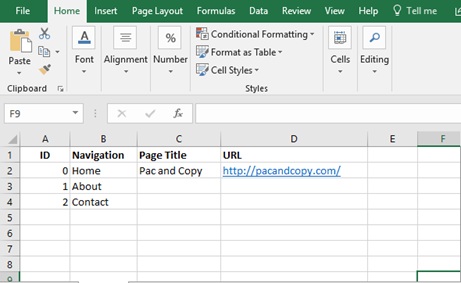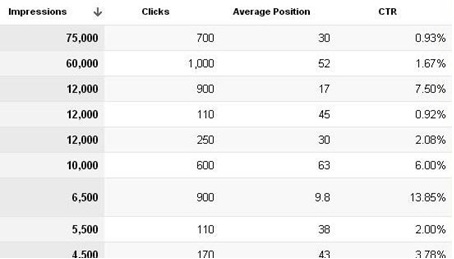
If you are on a mission to improve the content marketing game of your website, you must pay attention to content audits. Content optimization is improved through regular audits on the website. It is easy to grab a few tools and gather some statistics, but you must know how to use this data in your favor to build a data-driven content strategy. Don’t get lost in the quick sections of your analytics tool.
If you are embarking on this mission for the first time, here is a roadmap for you to follow:
Make a spreadsheet
The first thing you should do is to create a spreadsheet for the audit, listing down your motives and sections to look out for. Spreadsheets are the most flexible, editable, and can be synced to the cloud easily. You can easily coordinate with your peers all over the world through spreadsheet files.
Make a list of the main section of your site on the sheet. It doesn’t matter if you run a small website or a site consisting of thousands of pages, the sections are mostly same. ID, Navigation, Page titles and comments for each listing are some sections, to begin. Use separate columns for each section.

Choose a page and just start collecting information about it and putting it in the spreadsheet. Make separate columns if a page has sub-pages. Keep going and listing the whole website as you will need this data to carry out other analytical processes. It will make a database which you can use whenever you have to refer back to the history of changes made to any page on your website.
A good content management system is a huge help when you are listing down information about pages. The reason behind this help is that the content is already well-structured in a good CMS. It cuts the time you could waste in figuring out page structure and navigation. Keep in mind that the first content audit will not happen in a day or two, it takes time and planning to carry out a content audit on your website.
If you are auditing a new site, you can list down the materials that were used to bring the website to life. Any printed manuals, background work, and paper forms should be documented for future reference.
Keep a separate column for pages or elements which require priority. This happens in the cases where you are conducting the audit for a specific reason and need to get specific answers to an element of the site. Put it as a separate heading so that the topic doesn’t leave your mind. It can be traffic; it can be a call to action. It can even be a lagging element that you want to keep a special eye on. In any case, keep the column separate so you can work on it during the audit.
Categorize
To start with the most useful areas, you should categorize your content. The spreadsheet listing will help you identify the popular and most important pages of your site. The data you have collected is going to be analyzed as per the need of your content audit. You will be clearer in your efforts once you go through your first content audit. Few data points will enable you to prepare a structure and move on to the next step.
Here is when you will find out whether your content is having the expected impact on your target audience. Just because you publish content doesn’t mean it is popular with the target audience. You will find out that various content pieces of your website are underperforming. Highlight these sections so you can figure out a way to get around this hindrance.
Other categories may include
- Organic traffic on separate content and website every month/day/week
- Meta descriptions
- Website bounce rate
- Average time spent on page
- Backlinks pointing to and from your site pages
- URL authority
- Social media impact
You don’t have to do this exercise alone since it can easily take span of 3-4 days. Get a trusted tool like Screaming Frog to make these lists or work with a bigger team to collaborate effectively. You can also get help from a skilled programmer who can pull all this data from APIs to save time in your first audit.
Landing pages
Some of the best sources of information before a website audit can be the Google Webmaster Tools.
Once you are on, go to Search Queries and get a detailed list of keywords the users are sending which help your website rank. The content audit takes this to the next level by figuring out the what and why of the equation.

Your landing pages will be picked up and analyzed during a content audit to measure the keywords which are having a huge impact. Measure the ‘entrances’ metric using Google Analytics which can find out how the user came to your site. Don’t forget to work closely with both Google Analytics and Google Webmaster Tools. Take a look, and you will get an idea of the popularity of your land pages based on page structure and content.
SEO links
A content audit is incomplete without an SEO analysis. SEO and content go hand in hand so you can analyze why a page is going to be more popular based on the SEO score. It can also inform you about the content people are more interested to read.
Here are the metrics you can measure to build a stronger SEO strategy:
- Unique visitors: this number tells you about one of a kind visitors who approached your site with a goal. Find out what brings new people to your site and how you can turn into a conversion factor
- Returning visitors: this number defines how impactful your content strategy is proving to be. If a page has a high number of returning visitors, invest in that kind of content more.
- Referral sources: these are the ambassadors spread in the digital world who like to talk about your website on their mediums. These referrals bring traffic to your pages. This will give you an idea about the topics people have in mind when they land on your site
- Bounce rate: just like page views tell you what you’re doing right, bounce rate tells you what went wrong. Why did the user leave your pages and what can you improve to bring more users and lower this rate, you will find out after analyzing the bounce rate
- Page load time: often, site speed and page load times are the only factors which work against the popularity of a site. Through a content and SEO analysis, you can cut down the factors which are increasing load times
- Keywords: as mentioned above, keywords are the life and soul of an SEO strategy. Look for high volume keywords which come for the lowest competition
- Outgoing links: these links work in your favor by guiding the user to the next most useful resource. You build a strong reputation of your site by building good links, and the user trusts your referral
- Demographics: you can find out the demographics and work on a user persona for your site. Once a persona is developed, you will be able to create content that speaks directly to the kind of people who visit your profile
Competitor analysis
This is an important area which can help you fix some loose ends on your end. Competitor analysis is nothing to be ashamed of; it is a good way to learn from your mistakes and perform better. There might be a keyword you are missing out on, or a direction you didn’t think of, which can be picked from the competitor analysis.
Competitor websites which have been around for longer can be a great source of information in your first content audit. If the websites have been around for long, you can see what they have done right and what they are doing right (or wrong).
You must keep in mind that the performance of your pages will be tied to the pages of your competitor. Let’s say you are an e-commerce brand which deals with electronics. You have to keep an eye on giants like Best Buy or Amazon because people will expect the same experience on your site. If you are not incorporating product videos or multiple payment gateways like other websites, the user will hop off to a website that does.
If you are a B2B oriented website, people will expect the same or better experience from your website and compare you with other brands in the niche. You can’t be stubborn and hold on to page elements that are dear to you. in this regard; you must go for the content popularity in your target audience.
Look at this landing page of HubSpot, which contains clear calls to action and messages for the user:

If your competitor is HubSpot and they are structuring their website like this, you can’t display pages that don’t click. These pages are structured, and navigation is top-notch as well. You can’t justify a poor user experience in any case because the conversion rate will keep getting low and in favor of the best website.
Competitor analysis gives you an update on all the trusted and tried strategies others are using in the industry and why you can benefit from them. However, based on the nature of your business, it is entirely up to you to choose the method that clicks.
Off-site content
Just like the content on your site, offsite content is of immense importance. If you are finding out about the importance of your content, look into ways which can help you grow traffic while staying on the organic path. Content helps in bringing organic visitors to your site.
This is largely dependent on your use of the tool. A good tool will be savvy in picking up the metrics for your offsite content. Gather what you can through Google Analytics and Webmaster tools and look for other options that can highlight your content offsite.
You can plan the launch of your next big content release based on the pattern and number of traffic that approached your site via reference. If it is a guest post or a consultancy article, you can find out the type of people who would love to hear more from you about a topic. Start the trend on your site/blog to provide value to your readers and establish your position as a thought leader in the industry. As soon as you start educating your audience, people will prefer your brand/website over those who copy or provide incomplete info.
Content is king
It is a good thing to invest in a content audit. It is also one of the most rewarding things you can do for your website. In the digital arena, it is important to know where you stand and what the next step is. Whether you are hiring a team, doing it alone or making extensive lists, a content audit is always beneficial.
If you feel unsure about a page and two content pieces are clashing regarding popularity, the best way is to A/B test both pieces. This guide will tell you what A/B testing is and how it can pick the winner for you while keeping users in mind.
The process sounds long and tedious, but it has its rewards for the future of your website. You can stop investing in resources which are not bringing any traffic and double up on a strategy that is more user-friendly. The first content audit will give you a hard time, but the drill will become easier as you repeat it. You will be more informed about the industry where you work and the niche as well. In the age of Big Data and data-driven strategies, you can only improve and learn more so that your website doesn’t fade out into the abyss.